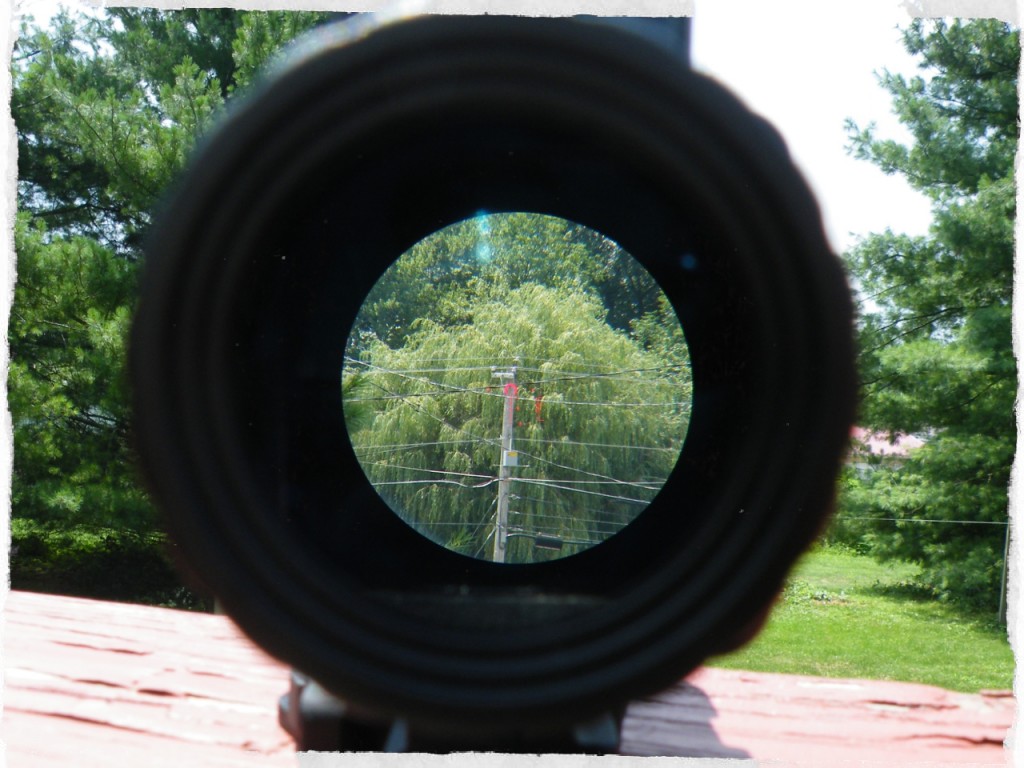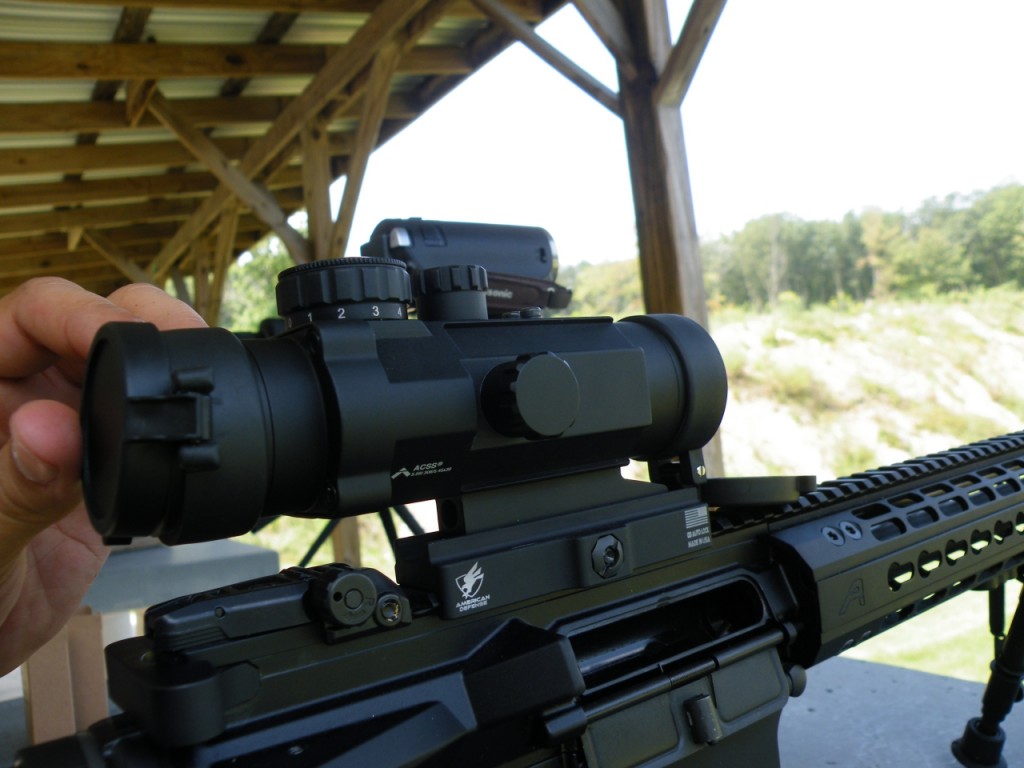I received the PAC4x for evaluation from PA after a chance online meeting. I was offered the chance to test the Primary Arms optic get some range time with it on my newly renovated club range.
The Primary Arms PAC4X falls into the class of an entry level consumer optic. At $289 with a ADM mount, the product offers substantial savings over many other fixed magnification optics on the market. When I first handled the optic it became clear that it had a decent level of quality control despite being made overseas. The anodizing is smooth, and the machining of the optic is also extremely well done with no tool markings or irregularities. The caps thread onto the brass adjusters smoothly and without burs.
The optic is powered by a CR 2032 battery for illumination and the dial goes to 11. It is daylight visible, and you should find it suitable for most lighting conditions… though in bright outdoors light when aiming at a light background the red does get subdued a bit, but is still visible. The rear of the optic has an adjustable focus ring which will keep you shooting with a clear sight even as your RX or eyes age.

The glass was clear and I had no difficulty taking the optic to 600 yards. The daylight illumination is a bit better than in this photo.
The glass is clear and is absolutely head and shoulders above many of the cheap optics I have handled over the years. When I compare it to my Razor HD II I can tell a slight difference in quality and clarity with the edge going to the Razor… but that’s a really tough comparison for the naked eye. It’s really close to the point of diminishing returns. The optic features a longer eye relief than ACOGs and ACOG style clones, but this causes us to lose some of the field of view. At 23.6 feet at 100 yards, the optic has a fairly narrow field of view. Compare that to an ACOG at 36.8 feet and you can understand the difference is very noticeable. Inversely, compare the 1.5 inches of eye relief of the ACOG to the 3.2 inches of the PAC4X. That too is a large difference.
“The Engine That Drives the Optic”
The reason I was sent this optic is simple: Primary Arms has big hopes for their reticle systems. When I talked with the designer of the reticle, it was clear to me that he took great care in drafting a reticle which was designed to get rounds on target quickly and easily. The ACSS reticle is a traditional CQB horse shoe with bullet drop stadia coupled with 5mph wind holds. The stadia allows shoulder width based ranging and to the right is a height based measurement tool for additional ranging capabilities. The two large dots next to the CQB circle are 8.6 mph running leads designed for a 0-300 yard target running at 8.6 MPH which is the average measurement of someone running with a weapon according to PA. My version of the PAC4X is calibrated for M193 Ball ammo.
The instructional printout that comes with the optic has a variety of loadings that can be sighted in with the optic, as well as a chart that explains how to sight in the optic with different barrel lengths based on your elevation. Primary Arms wants to make it as easy as possible to get up and running with the optic to make sure you get hits with the reticle. In my discussion with the designer, he wanted to ensure the shooter had all the tools necessary to range and fire upon targets both near and far. Having both wind holds and two means of range estimation are part of a total solution to hitting a distant target.
Other reviews and reviewers might take this optic out to 100 yards and call it a day. At TNR, we have the capability. We have the range. We can do this. Is this blog about marksmanship? YES.
Let’s take the PAC4X out to 600 yards. Let’s test “the engine that drives the optic.”
At Range: The PAC4x and the ACSS

The PAC4x was a no drama optic to use. Sight in was quick with my sight in target and allowed me to gauge how well the turrets tracked each 1/2 minute adjustment. I was able to get dead on at 100 yards with M193 rather quickly. The ADM mount allowed me to remove and re-attach without a noticeable loss of zero. I threw the optic down into the field for a very basic drop test and re-attached; I could not perceive a shift in zero.
Remember, at 4x and calibrated for m193… If there was some slight shift, I probably wouldn’t be able to notice with M193, but after the drop and re-attach the optic was taken out to the long-range without issue. I used a bi-pod for accuracy testing.
I was able to easily hit targets at 100-200-300-400-500 and 600 yard silhouettes with the optic. I encountered little wind on my range day, so I was unable to test out the wind holds with M193, but I have no doubt you will find that the holds are spot on. See the above video for a visual of the 600 yard shooting.
Wrapping Up:
Overall the optic and reticle system work well. At this price point, it makes a good choice for the entry-level market. If you need something with a reputation for durability or you want an optic for SHTF, its hard to recommend something at this price point. As I go down the road, I will drop test and dunk the PAC4x to see how it holds up. For this review I wanted to see how the ACSS system worked, and it appears to work well.
The ACOG with the ACSS reticle is out now, and will satisfy the needs of someone requiring a system whose durability is well-known. For now, I wouldn’t hesitate to point a shooter on a limited budget to the PAC4x. It has clean glass, excellent instructions, and offers a substantial value for the money, and the ACSS reticle will get you shooting out to extended distances in a hurry.
+ Price for performance
+ ACSS reticle works well
+ Excellent ballistic / zeroing instructions for different setups
+ Includes flip covers and picatinny rail for micro rds
– Narrow field of view







